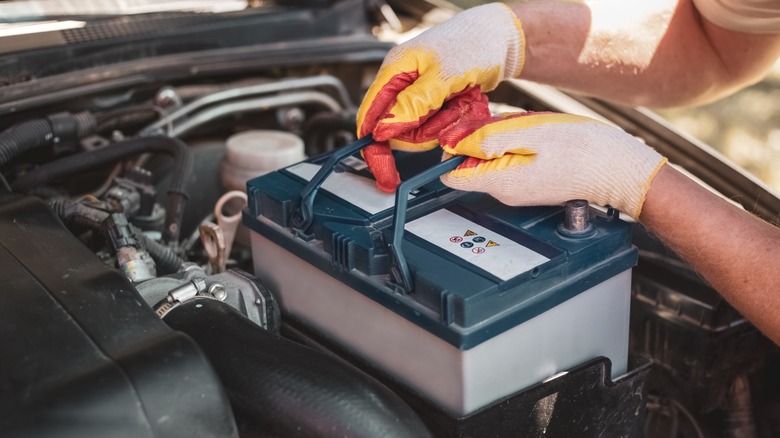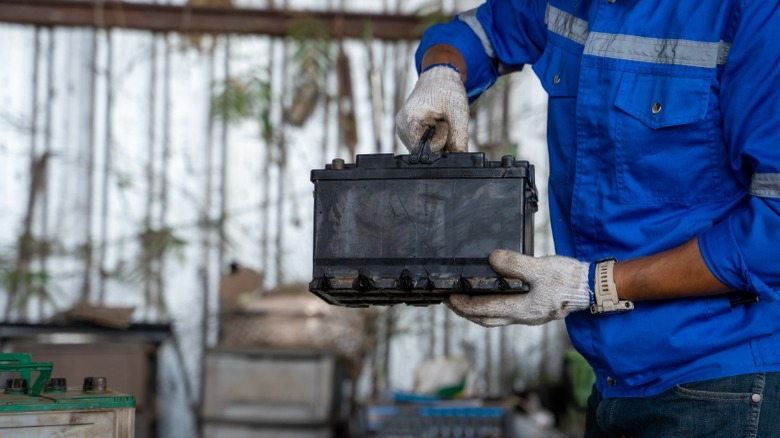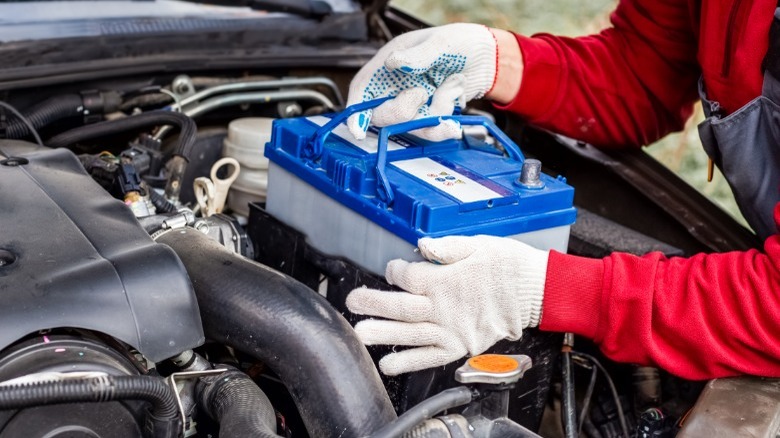How To Disconnect Your Car's Battery (And When You Might Need To)
Your car's 12-volt battery is one of its most vital components. It's responsible for sending electricity to the starter motor, which, in turn, sends power to the ignition system and cranks the engine. The battery also powers accessories, like the radio, air conditioning, and power windows, when the engine is turned off and the ignition key is in the ON position. While it's only in use for a second under normal conditions, your car's battery has a big job, and if it fails, you won't be able to start your engine without outside help.
Normally, you need to replace your vehicle's 12-volt battery every three to five years. But sometimes, automotive batteries can fail prematurely due to things like a parasitic power drain, damage, and a faulty alternator. Your car's battery may also die early if you forget to turn off your lights or run the AC and radio while the engine is turned off. Regardless of the reason it fails, though, when your 12-volt battery dies, you'll most likely have to replace it. You can recharge car batteries in some cases. However, automotive batteries don't last forever, even if you maintain them properly.
At some point, you're going to have to replace your car battery. When it comes time to do so, don't freak out — replacing a 12-volt battery is quick and simple. In fact, it's one of the best DIY engine maintenance tasks you can do at home. If you're curious about how to disconnect your car's battery and why you might need to do so, we've got you covered. Here's how to remove a 12-volt automotive battery and some of the reasons why you might need to do it.
How to disconnect your car's battery
Most standard car batteries are located under the hood near the front of the engine bay. Yours may be positioned toward the right or left side of the engine bay, and it will most likely be sitting on top of a small, rectangular tray. Removing your car battery doesn't require advanced automotive knowledge or expensive tools, but you will need a few basic devices, like a socket set or some wrenches — there is no standard size for battery terminal and tie down nuts, but 8-millimeter and 10-millimeter are two of the most common sizes. With the vehicle turned off, follow the steps below:
-
Remove the battery terminal covers by sliding them back on the cables.
-
Remove the negative battery terminal (the black cable) by loosening the nut and sliding the terminal off the battery terminal post.
-
Remove the positive terminal (the red cable) by loosening the nut and sliding the terminal off the battery terminal post.
-
If your car battery has a tie down or metal bracket holding it in place, remove it by disconnecting the nut and setting the bracket to the side.
-
Remove the old battery from the vehicle.
Those are the general steps to remove your car's battery. The process is the same for most vehicles. However, it's worth checking your owner's manual or repair guide before you get started to make sure there aren't any special steps involved for your car. When it comes time to reinstall the battery or connect a new one, all you have to do is follow the steps in reverse.
When do you need to disconnect the battery?
Generally, you don't need to disconnect your car battery very often. In most cases, you only need to remove your 12-volt battery if you're having trouble starting your vehicle. There are various reasons why your car won't start. However, a dead battery is one of the most common, and if yours dies, you'll need to disconnect and remove your battery to replace it.
But there are other times during which you may need to remove your car's battery. One common reason why you might remove yours is if you want to get it tested. You can test a car battery while it's connected to the vehicle. However, if your car won't start, you may not be able to drive to the local repair shop or parts store for a test — and if you aren't positive that your battery is the cause of your car's inability to start, it's worth getting a test before forking over the money for a new one.
You also may need to disconnect your battery during various auto repair jobs, especially when working on the electric system. It's common to disconnect at least the negative terminal while performing repair or maintenance jobs that require us to handle electrical components. Doing so prevents shocks, injuries, and damage — it's also a solid habit to develop if you plan to do any auto repair work.
Finally, you may have to disconnect your battery to access another component. Car batteries can be large, and sometimes, they get in the way while working in the engine bay. Disconnecting and removing them is a quick and easy way to free up some space and take some of the hassle out of various repair and maintenance tasks.


